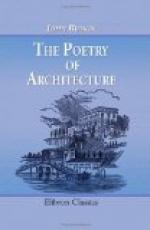157. Again, it is a thoroughly domestic building, homely and cottage-like in its prevailing forms, awakening no elevated ideas, assuming no nobility of form. It has none of the pride, or the grace of beauty, none of the dignity of delight which we found in the villa of Italy; but it is a habitation of everyday life, a protection from momentary inconvenience, covered with stiff efforts at decoration, and exactly typical of the mind of its inhabitant: not noble in its taste, not haughty in its recreation, not pure in its perception of beauty; but domestic in its pleasures, fond of matter-of-fact rather than of imagination, yet sparkling occasionally with odd wit and grotesque association. The Italian obtains his beauty, as his recreation, with quietness, with few and noble lines, with great seriousness and depth of thought, with very rare interruptions to the simple train of feeling. But the Englishman’s villa is full of effort: it is a business with him to be playful, an infinite labor to be ornamental: he forces his amusement with fits of contrasted thought, with mingling of minor touches of humor, with a good deal of sulkiness, but with no melancholy; and therefore, owing to this last adjunct,[30] the building, in its original state, cannot be called beautiful, and we ought not to consider the effect of its present antiquity, evidence of which is, as was before proved, generally objectionable in a building devoted to pleasure,[31] and is only agreeable here, because united with the memory of a departed pride.
[Footnote 30: Namely the fact that there is no melancholy in the English play-impulse; v. ante, Sec. 23.]
[Footnote 31: See Sec. 118 seq.]
158. Again, it is a lifelike building, sparkling in its casements, brisk in its air, letting much light in at the walls and roof, low and comfortable-looking in its door. The Italian’s dwelling is much walled in, letting out no secrets from the inside, dreary and drowsy in its effect. Just such is the difference between the minds of the inhabitants; the one passing away in deep and dark reverie, the other quick and business-like, enjoying its everyday occupations, and active in its ordinary engagements.
159. Again, it is a regularly planned, mechanical, well-disciplined building; each of its parts answering to its opposite, each of its ornaments matched with similarity. The Italian (where it has no high pretense to architectural beauty) is a rambling and irregular edifice, varied with uncorresponding masses: and the mind of the Italian we find similarly irregular, a thing of various and ungovernable impulse, without fixed principle of action; the Englishman’s, regular and uniform in its emotions, steady in its habits, and firm even in its most trivial determinations.
160. Lastly, the size of the whole is diminutive, compared with the villas of the south, in which the effect was always large and general. Here the eye is drawn into the investigation of particular points, and miniature details; just as, in comparing the English and Continental cottages, we found the one characterized by a minute finish, and the other by a massive effect, exactly correspondent with the scale of the features and scenery of their respective localities.




